Abstract
Ro 23-9424 is a dual-action cephalosporin with an aminothiazolylmethoxyimino-type side chain at the 7 position and fleroxacin esterified at the 3' position. The new compound has broad and potent antibacterial activity in vitro and in vivo, reflecting contributions from both the beta-lactam moiety and the quinolone moiety. In animals, the ester bond potentially could be hydrolyzed enzymatically or nonenzymatically, to yield the active metabolites desacetylcefotaxime and fleroxacin. The extent to which Ro 23-9424 acts in vivo as a true dual-action cephalosporin, or acts as a combination of active metabolites, is therefore a function of its pharmacokinetic properties. To investigate these properties, Ro 23-9424 was administered as a single intravenous dose of 20 mg/kg of body weight to mice, rats, dogs, and baboons. Timed plasma samples were assayed by an ion-paired high-pressure liquid chromatography method that allowed detection of both intact Ro 23-9424 and fleroxacin. The pharmacokinetic parameters of Ro 23-9424 were similar to published results for cefotaxime, while concentrations of fleroxacin in plasma were low and fairly constant (about 1 to 3 micrograms/ml) in all species, suggesting that excretion of the intact molecule is a major route of elimination for Ro 23-9424, as it is for cefotaxime. For technical reasons, urinary recovery of Ro 23-9424 was not quantitated, but intact Ro 23-9424 was found in high concentrations (greater than 400 micrograms/ml) in mouse urine aspirated directly from the bladder. In all species, low concentrations of free fleroxacin in plasma persisted after the elimination of Ro 23-9424 was complete, but fleroxacin did not accumulate unduly in a 14-day multiple-dose experiment in baboons. Thus, it seems likely that the activity seen in vivo is primarily due to intact Ro 23-9424, although the low levels of free fleroxacin may also have some therapeutic significance.
Full text
PDF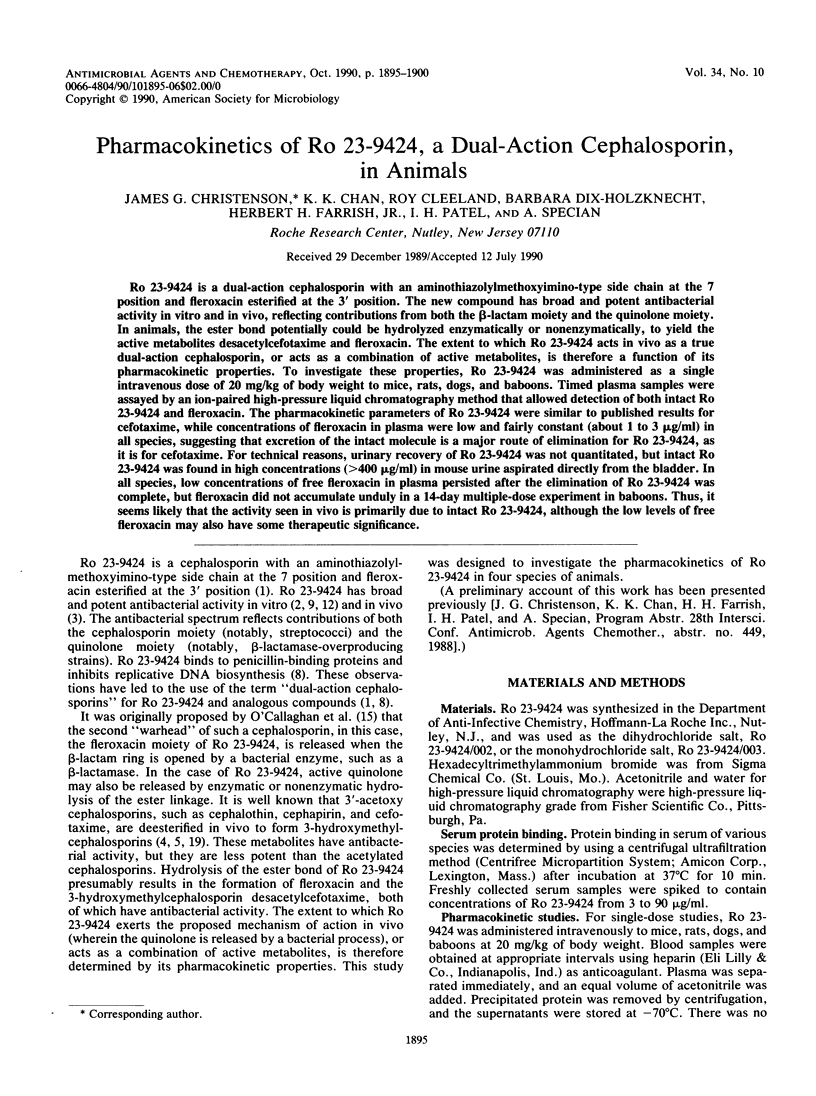
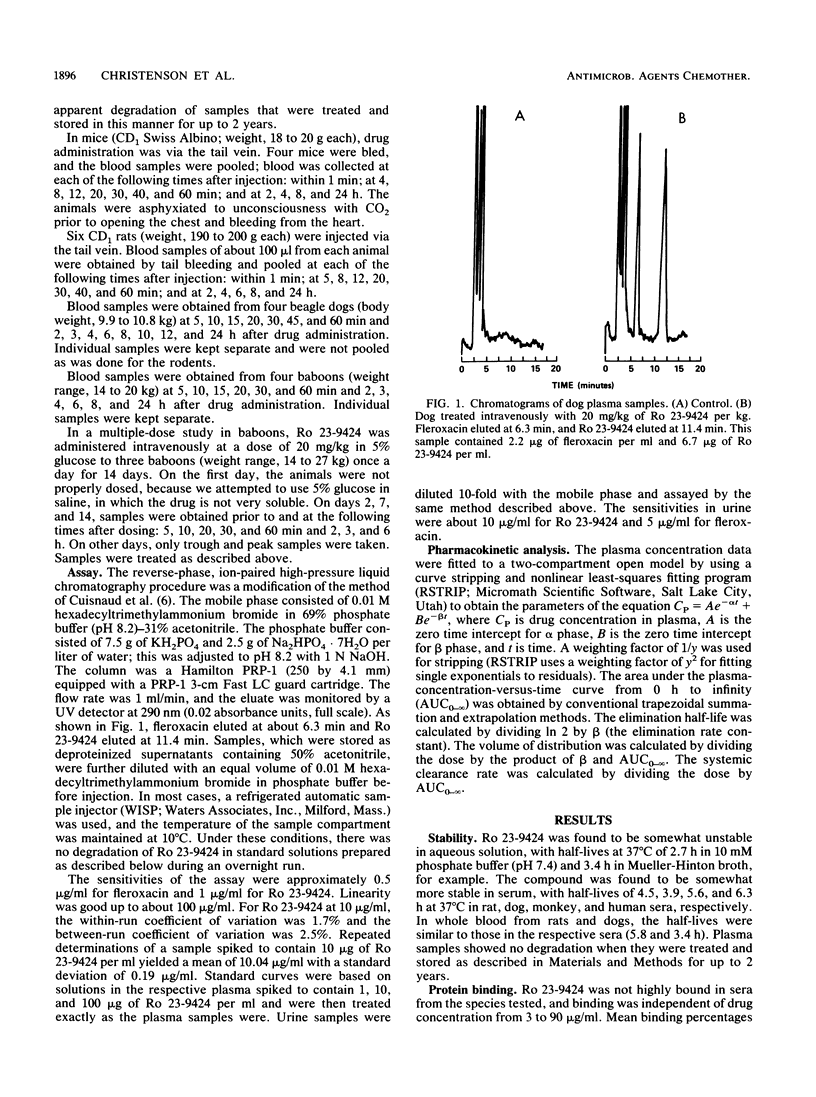
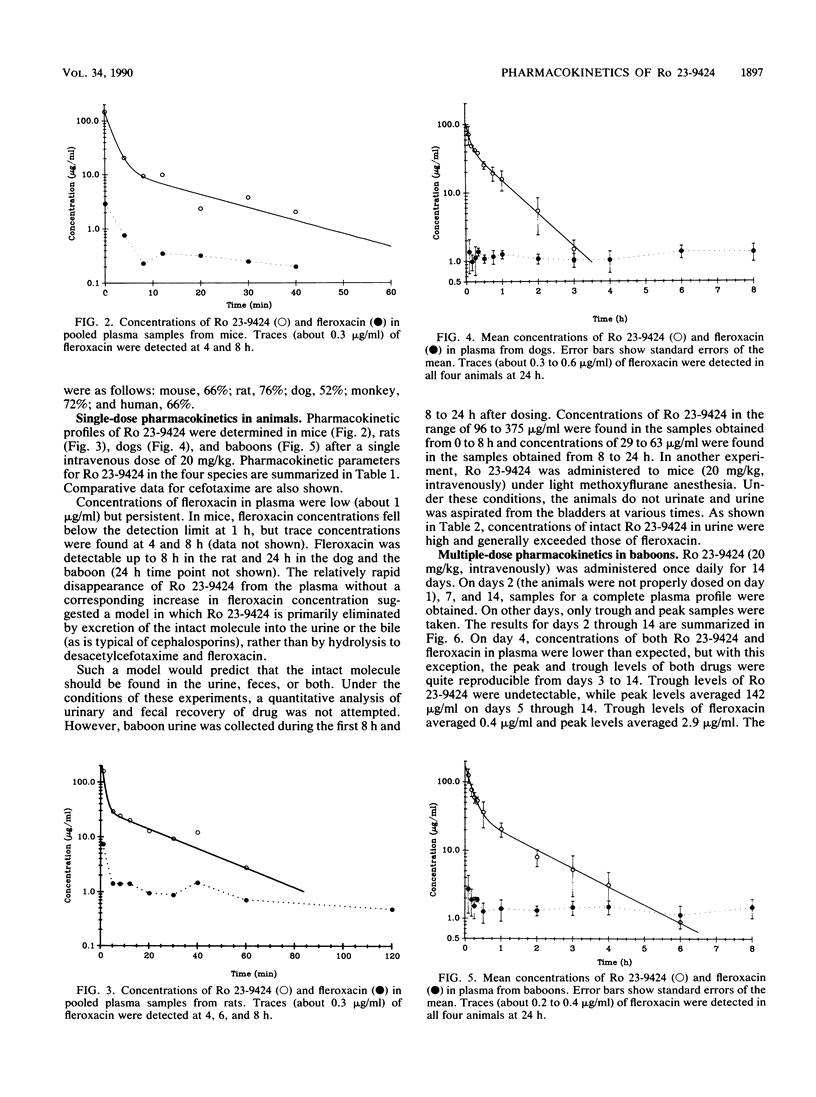
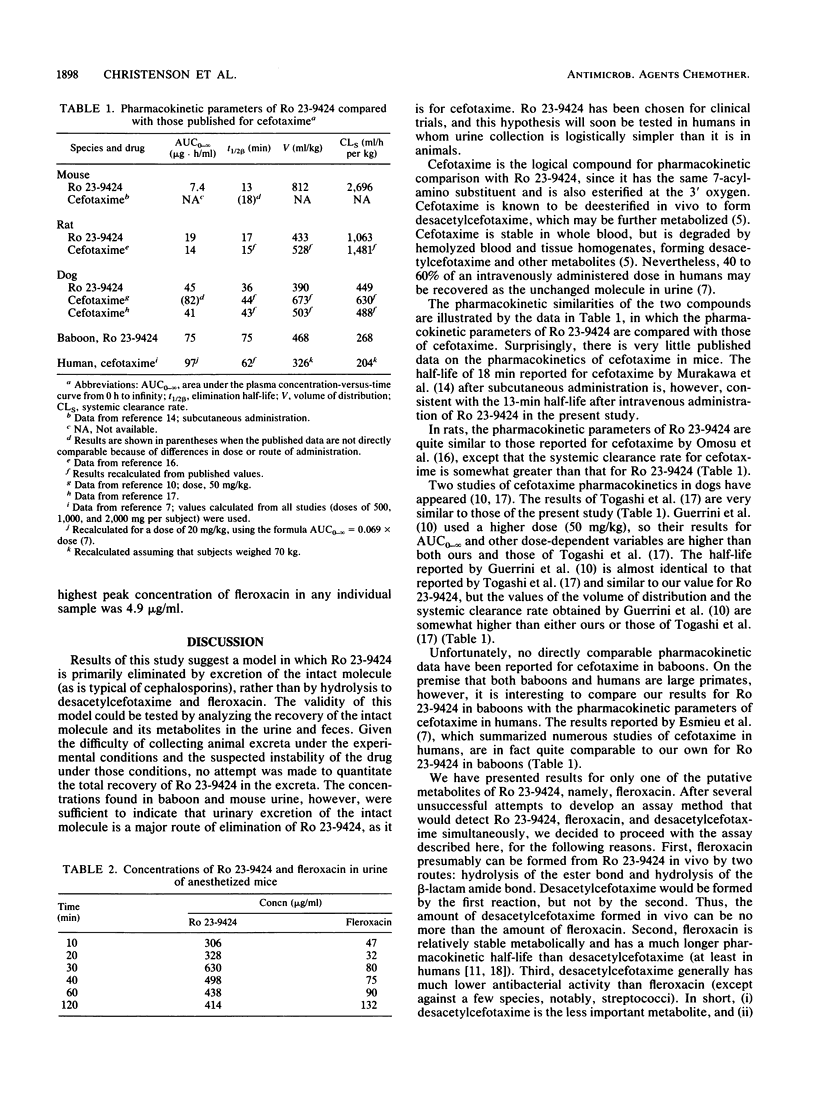
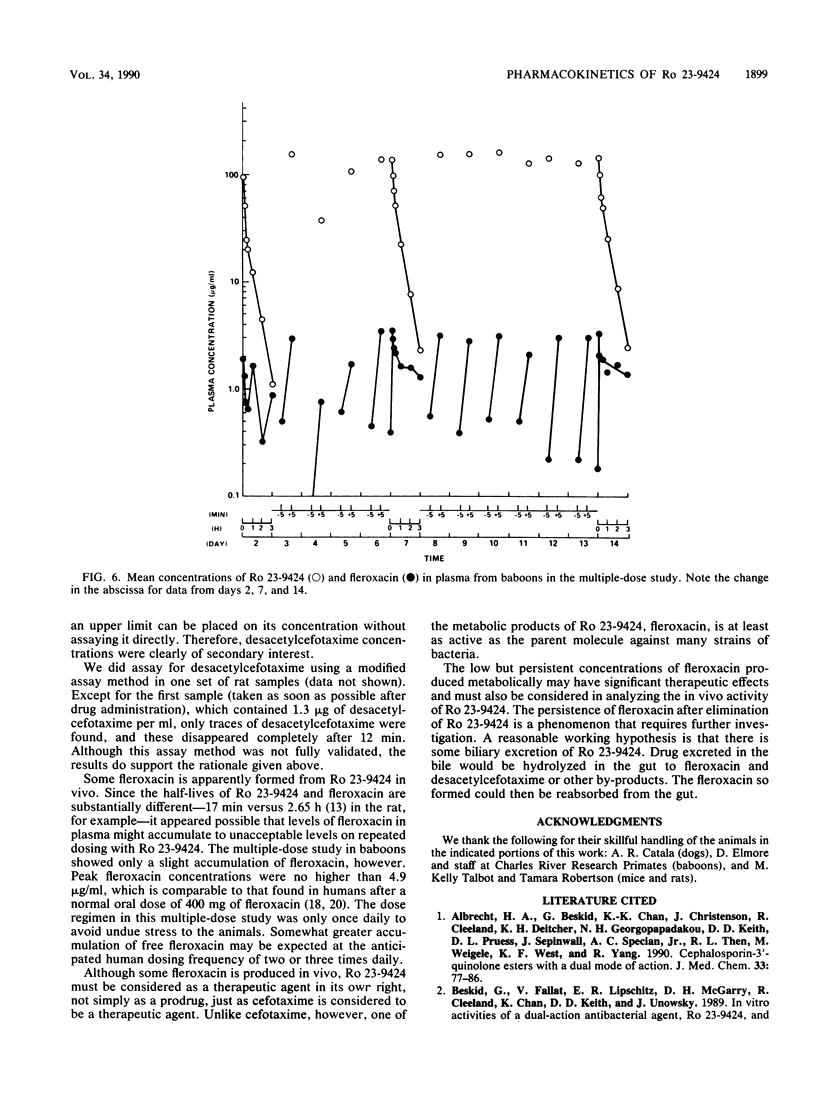
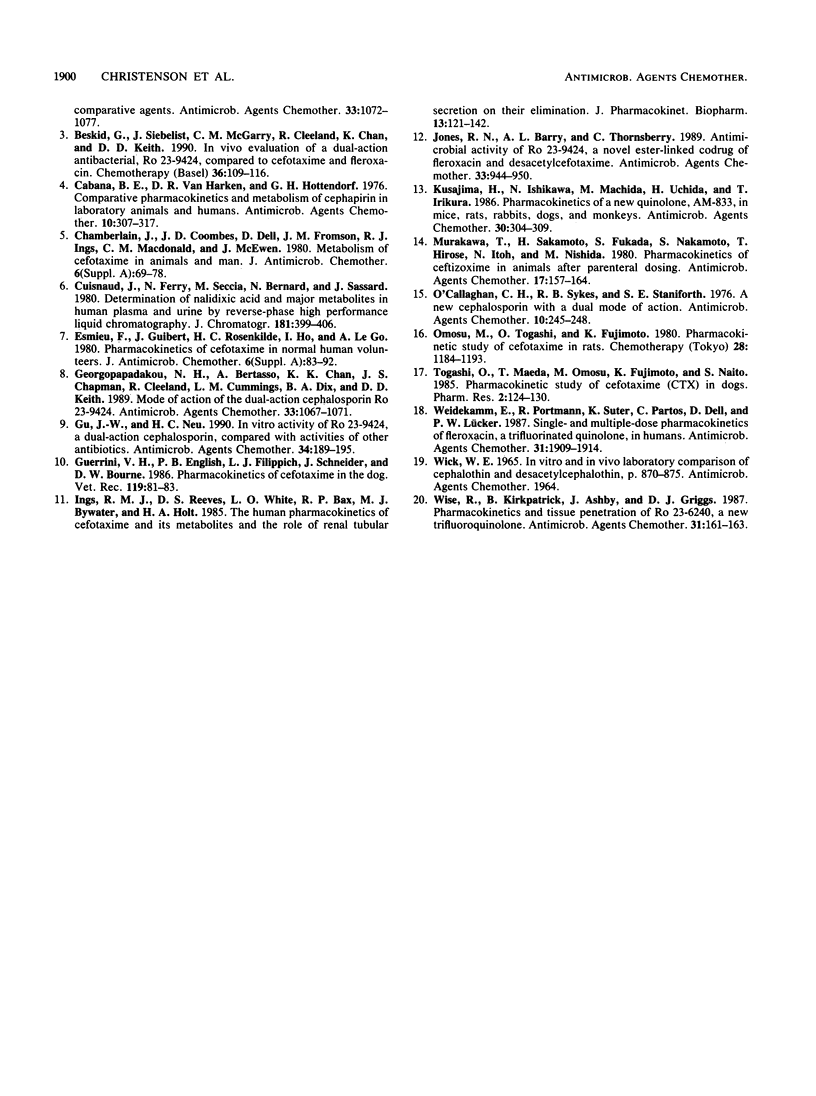
Selected References
These references are in PubMed. This may not be the complete list of references from this article.
- Albrecht H. A., Beskid G., Chan K. K., Christenson J. G., Cleeland R., Deitcher K. H., Georgopapadakou N. H., Keith D. D., Pruess D. L., Sepinwall J. Cephalosporin 3'-quinolone esters with a dual mode of action. J Med Chem. 1990 Jan;33(1):77–86. doi: 10.1021/jm00163a013. [DOI] [PubMed] [Google Scholar]
- Beskid G., Siebelist J., McGarry C. M., Cleeland R., Chan K., Keith D. D. In vivo evaluation of a dual-action antibacterial, Ro 23-9424, compared to cefotaxime and fleroxacin. Chemotherapy. 1990;36(2):109–116. doi: 10.1159/000238756. [DOI] [PubMed] [Google Scholar]
- Cabana B. E., van Harken D. R., Hottendorf G. H. Comparative pharmacokinetics and metabolism of cephapirin in laboratory animals and humans. Antimicrob Agents Chemother. 1976 Aug;10(2):307–317. doi: 10.1128/aac.10.2.307. [DOI] [PMC free article] [PubMed] [Google Scholar]
- Chamberlain J., Coombes J. D., Dell D., Fromson J. M., Ings R. J., Macdonald C. M., McEwen J. Metabolism of cefotaxime in animals and man. J Antimicrob Chemother. 1980 Sep;6 (Suppl A):69–78. doi: 10.1093/jac/6.suppl_a.69. [DOI] [PubMed] [Google Scholar]
- Cuisinaud G., Ferry N., Seccia M., Bernard N., Sassard J. Determination of nalidixic acid and its two major metabolites in human plasma and urine by reversed-phase high-performance liquid chromatography. J Chromatogr. 1980 Mar 14;181(3-4):399–406. doi: 10.1016/s0378-4347(00)81142-1. [DOI] [PubMed] [Google Scholar]
- Esmieu F., Guibert J., Rosenkilde H. C., Ho I., Le Go A. Pharmacokinetics of cefotaxime in normal human volunteers. J Antimicrob Chemother. 1980 Sep;6 (Suppl A):83–92. doi: 10.1093/jac/6.suppl_a.83. [DOI] [PubMed] [Google Scholar]
- Georgopapadakou N. H., Bertasso A., Chan K. K., Chapman J. S., Cleeland R., Cummings L. M., Dix B. A., Keith D. D. Mode of action of the dual-action cephalosporin Ro 23-9424. Antimicrob Agents Chemother. 1989 Jul;33(7):1067–1071. doi: 10.1128/aac.33.7.1067. [DOI] [PMC free article] [PubMed] [Google Scholar]
- Gu J. W., Neu H. C. In vitro activity of Ro 23-9424, a dual-action cephalosporin, compared with activities of other antibiotics. Antimicrob Agents Chemother. 1990 Feb;34(2):189–195. doi: 10.1128/aac.34.2.189. [DOI] [PMC free article] [PubMed] [Google Scholar]
- Guerrini V. H., English P. B., Filippich L. J., Schneider J., Bourne D. W. Pharmacokinetics of cefotaxime in the dog. Vet Rec. 1986 Jul 26;119(4):81–83. doi: 10.1136/vr.119.4.81. [DOI] [PubMed] [Google Scholar]
- Ings R. M., Reeves D. S., White L. O., Bax R. P., Bywater M. J., Holt H. A. The human pharmacokinetics of cefotaxime and its metabolites and the role of renal tubular secretion on their elimination. J Pharmacokinet Biopharm. 1985 Apr;13(2):121–142. doi: 10.1007/BF01059394. [DOI] [PubMed] [Google Scholar]
- Jones R. N., Barry A. L., Thornsberry C. Antimicrobial activity of Ro 23-9424, a novel ester-linked codrug of fleroxacin and desacetylcefotaxime. Antimicrob Agents Chemother. 1989 Jun;33(6):944–950. doi: 10.1128/aac.33.6.944. [DOI] [PMC free article] [PubMed] [Google Scholar]
- Kusajima H., Ishikawa N., Machida M., Uchida H., Irikura T. Pharmacokinetics of a new quinolone, AM-833, in mice, rats, rabbits, dogs, and monkeys. Antimicrob Agents Chemother. 1986 Aug;30(2):304–309. doi: 10.1128/aac.30.2.304. [DOI] [PMC free article] [PubMed] [Google Scholar]
- Murakawa T., Sakamoto H., Fukada S., Nakamoto S., Hirose T., Itoh N., Nishida M. Pharmacokinetics of ceftizoxime in animals after parenteral dosing. Antimicrob Agents Chemother. 1980 Feb;17(2):157–164. doi: 10.1128/aac.17.2.157. [DOI] [PMC free article] [PubMed] [Google Scholar]
- O'Callaghan C. H., Sykes R. B., Staniforth S. E. A new cephalosporin with a dual mode of action. Antimicrob Agents Chemother. 1976 Aug;10(2):245–248. doi: 10.1128/aac.10.2.245. [DOI] [PMC free article] [PubMed] [Google Scholar]
- Weidekamm E., Portmann R., Suter K., Partos C., Dell D., Lücker P. W. Single- and multiple-dose pharmacokinetics of fleroxacin, a trifluorinated quinolone, in humans. Antimicrob Agents Chemother. 1987 Dec;31(12):1909–1914. doi: 10.1128/aac.31.12.1909. [DOI] [PMC free article] [PubMed] [Google Scholar]
- Wick W. E. In vitro and in vivo laboratory comparison of cephalothin and desacetylcephalothin. Antimicrob Agents Chemother (Bethesda) 1965;5:870–875. [PubMed] [Google Scholar]
- Wise R., Kirkpatrick B., Ashby J., Griggs D. J. Pharmacokinetics and tissue penetration of Ro 23-6240, a new trifluoroquinolone. Antimicrob Agents Chemother. 1987 Feb;31(2):161–163. doi: 10.1128/aac.31.2.161. [DOI] [PMC free article] [PubMed] [Google Scholar]


